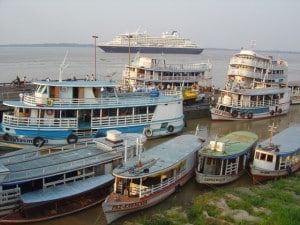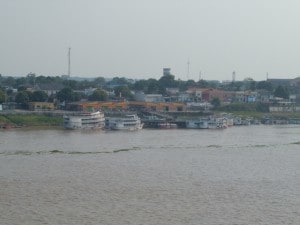We all thought that having left Manaus behind us would mean that all our troubles would be over and we would be able to adhere again closely to the planning of our cruise. Well, no. The Amazon had another surprise for us in store. It had to do with the strong current of the Amazon but also to do with the work load of the pilots. For some reason there is currently a lot of traffic on the river, so many ships are going up and down that the pilot associations have a hard time servicing all these vessels. Therefore the two pilots assigned to the Prinsendam for the second part of the river where coming up with a tanker and would transfer at the pilot station. However that ship could not maintain it’s speed as planned and the ETA to the pilot station was getting later and later. In the end the ship was two hours behind the original schedule. That original schedule that I had to adhere to, to be on time in Parintins. So we were going to be late. Two hours late.
With the pilot transfer complete I cranked up the Prinsendam to full sea speed and soon we were flying with 23 knots down the river. I was hoping that I would still be able to drop the hook around 09.30 and have the tender operation going by 10 am as at 1100 hrs the Boi Bumba show was starting and the performers are known not to be willing to postpone their performance. We made good time, we even made up a bit of lost time and by 09.15 the Prinsendam appeared in front of Parintins. As we were coming down the river I had to turn the ship into the current to be able to anchor. This is a sort maneuver that you can compare with racing your car into the garage, pulling the hand brake, sliding around an 180o and coming to a stand still in your assigned parking lot. Fun to do but un-nerving to see because while you are making the turn, the ship is also pushed down river by the current quite rapidly. This time it was less dramatic than normal, as a strong wind of about 25 knots, blowing upstream dampened the influence of the current a little bit and that meant that the ship set downstream less fast. Once the bow was into the current, the tenders were lowered and the Prinsendam could slowly drift towards the anchorage position. This was a location about ¾ of a mile off Parintins floating dock where there is a bank in the river. The water depth near Parintins is about 60 meters but this bank is only 18 meters below the surface and thus a perfect place to put the anchor down on. By 09.50 we had the first tender ashore and the Boi Bumba tour was going. All was well in the world again.
 The ship from Parintins.
The ship from Parintins.
Two hours late in arrival, made me decide to sail two hours later as well and thus the guests could enjoy the same amount of time in Parintins as planned. I can easily make up those lost hours while sailing to our next port of call Devils Island a few days from now.
 Parintins from the ship.
Parintins from the ship.
Parintins has the distinction that it is normally our warmest port of call on the Amazon and on the bridge wing (sunny side) the Temperature topped 97oF at 2 pm. Although there was a strong breeze blowing, it did not do much to cool things down. Neither did the rain; we had some showers in the area but nothing fell on the ship and so we had yet another dry day during the Amazonia rain season. Remember the pilot in General San Martin? According to him it all had to do with “Global Hot” and I think that he was right.
By 4 pm we left the anchorage and once again swung the ship around, now heading south. Tomorrow is our final day on the Amazon and by tomorrow evening we should see open waters again and be back in the Northern Hemisphere. The Amazon expedition is coming to an end.

March 15, 2010 at 10:43 pm
Captain Albert,
Again, thank you for the time and effort in your blog, I follow it daily.
A question for when you get time. When do the tenders get fueled? I presume they use diesel, do you have an on board tank and pumps etc.?
Some day you’ll need to yell “Ramming Speed!” from the bridge wing to the Sunday sailors.:) Have a great voyage back to Florida.
Mark….
March 16, 2010 at 11:22 pm
Good morning,
Well, I will not yell ramming speed from the bridge as it would result in too much paper work…………….
Yes, all tenders use diesel fuel. They have a tank capacity large enough to sail for 24 hours with a continous speed of 6 knots, which is a requirement as they are also lifeboats. Hence we have to re-fuel after each port call to ensure that they have full tanks. So what we do, is as soon as there is a quiet time in the guest traffic going ashore or coming back, normally around 11 am or 2 pm. we refuel the tenders. For that purpose we have a pumping station in the aft bunker breaks, near the water line. (Where we normally refule the ship itself) Then for about 20 minutes we take each tender out of operation, park the tender alongside that hull opening and top the fuel tanks up again. That is done by the tender machinest, which is a engineroom petty officer who sole duty it is to look after the well being of the tenders. He overhauls the engines on a regular basis and carries out the necessary maintenance.
Best regards
CAptain albert
March 16, 2010 at 1:09 pm
Captain Schoonderbeek,
I just found your blog and sailed with you years and years ago (entertainment department) and thought I would let you know that I enjoy reading your blog. You are a very good writer, both informative and entertaining.
Keep up the good work, sailing and writing.
Jessica Meikle Davis
March 17, 2010 at 6:11 am
I’m thinking these wee glitches in schedule are all part of the whole experience. Somehow if everything goes according to schedule, it is boring. Oh, I know schedule is important to you, the company and all involved–except for the passengers. I’m just saying, were I sailing with you, I would regard the unexpected as an adventure.
March 17, 2010 at 6:31 pm
As you got ready to anchor at Parintins, Captain, you used a manoeuvre illustration which, of course, is far easier on ice. Something one of my Swedish-Finnish friends could without fail skilfully execute 🙂
But, 97°F!! I hope the engine room is air conditioned these days?
And yes; I remember the pilot in General San Martin. He was the one who suggested you go “inspecting” the anchorages for tankers just north of the Tres Candelabras lines. FYI; the March 2010 Nat. Geo. discusses the Nasca lines yet one more time.
And, thank you very much for having another reporter photographer in your Chief Engineer Jaap Wisse (what a power team)! The environment the locals live and work in are quite similar to the one Pacific islanders live in.